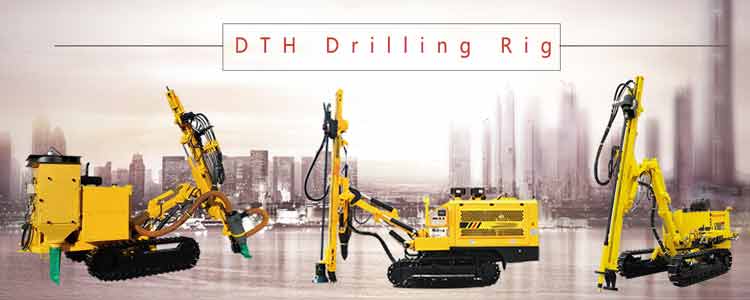
At present, down-the-hole drilling tools are widely used in construction sites such as open pit and underground mines, quarries, hydro power projects, water well drilling, mineral exploration, rock cable anchoring, Geothermal drilling, and subway excavation side pile support.
Because the down-the-hole drill has a series of features such as high straightness of the drill hole, smooth wall of the hole, good rigidity of the drill pipe and impactor, independent of high axial thrust, unrestricted drilling depth, low equipment investment and easy maintenance, it is widely valued by geotechnical engineering industry.
Preparation before drilling
- Check all air tube and oil tubefor damage and confirm that all hose connections are safe and reliable;
- Check if the tank hydraulic oil is sufficient and if the atomized lubricator has oil;
- Check if the lubrication of the lubrication part is suitable;
- Check the carriage, and remove debris;
- Check the fixing of the rotary machine on the safety board and whether the connection between the mounting plate and the carriage is in good condition;
- Check the air compressor air pressure value, the minimum pressure should not be lower than 0.55-0.7Mpa;
- Connect the rig to the compressor traction hook;
- After blowing out the air in the main air duct, carefully connect it to the main air duct joint of the drill;
- Before opening the main damper, check that the hose is completely tied to the safety rope;
- Check that all hoses are in good condition and that the connections are tight and reliable;
- Adjust the oiler.
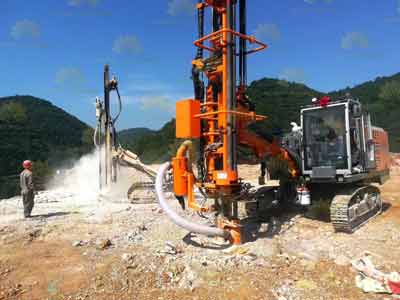
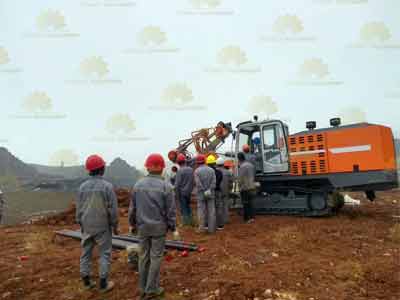
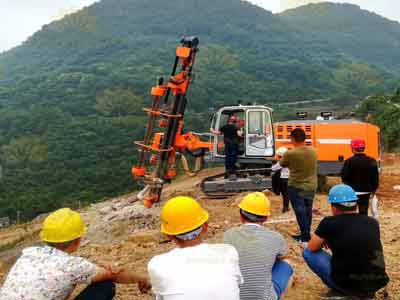
Drilling procedure
- Open the main air damper;
- Push the joystick to retract the rotary machine to the top of the carriage;
- Start the hydraulic valve;
- Raise the boom to its maximum height;
- Adjust the carriage to the desired position;
- Operate the compensation cylinder to extend the carriage so that the positioner falls in the punching position;
- Adjust the oiler needle valve until it sees oil droplets on the rotary duct;
- Slowly move the rotary machine down so that the impactor bit contacts the rock drilling surface while placing the factory control valve in a partially throttled position;
- After the rock hole is formed, place the impactor lever in the full flow position for formal work.
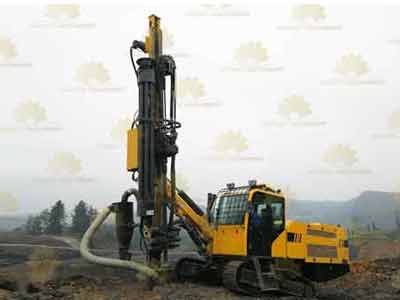
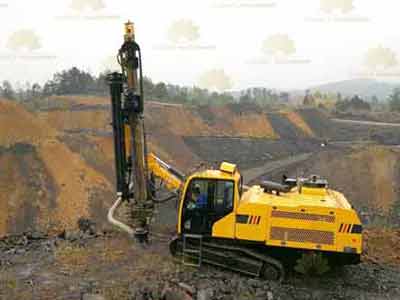

Connect Drilling rod
- When the slewing head is lowered to the lowest position, raise the slewing head so that the plate spigot on the drill pipe can be inserted into the position of the fork plate, stop the rotation and feed, and close the impact pressure;
- Insert the fork plate into the plate of the drilling rod and lower the slewing head, so that the positioning surface of the fork is placed on the centering drilling rod bushing;
- Use the retaining pin to block the fork plate, turn it in the opposite direction, and loosen the joint;
- Rotate the slewing head and raise it slowly until the joint and the drilling rod are completely loose. At this time, the drilling rod is hung on the centering device by the fork;
- Apply grease to the drilling rod thread and cover the drilling rod with a threaded protective cap;
- Apply grease to the next drilling rod thread;
- Use the drilling rod hanger to cover the male end of the drilling rod;
- Hang the drilling rod hanger with the drilling rod onto the lug of the post;
- Lift the slewing head until the drilling rod is fully suspended;
- Open the air pressure switch intermittently and blow the drilling rod clean with the wind;
- Remove the thread protection cap, slowly lower the slewing head, while slowly rotating forward, and align the female end to the male end of the previous drill pipe until the upper and lower joints are tightened;
- Gently lift the slewing head to remove the fork plate;
- At this point, complete.
Please note
- When loading and unloading the drilling rod, the spindle of the rotary machine must be rotated slowly to prevent the fork wrench from slipping out and causing injury to the operator.
- When loosening or tightening the drilling rod, the rotary machine spindle must rotated slowly to prevent the fork wrench from slipping out and causing injury to the operator.
- The inside and outside of the drill pipe must be cleaned before connect the drilling rod, otherwise the debris will break the normal operation of the impactor.
Related Products for Your Reference

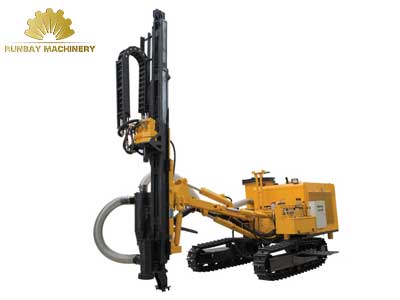

Leave Your Message
If you have any questions about our range of water well drilling rigs, pls dont hesitate to contact us. A member of our highly experienced and qualified team will be more than happy to help answer any questions you may have, helping you find the perfect solution for your needs.
